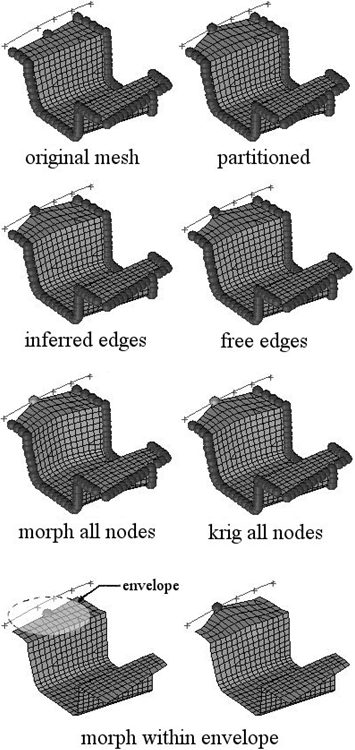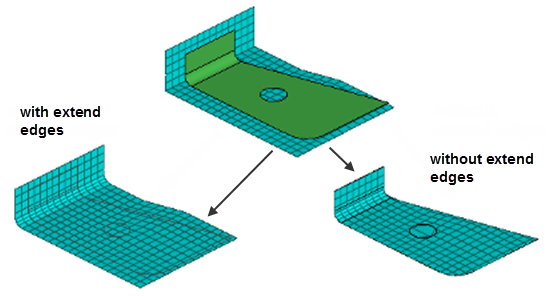Free Morph
Use the Free tool to morph mesh by moving nodes, handles, or domains, by applying shapes, or by mapping to geometry.
Manipulator Options
Use the following microdialog options to change the Move tool mode between translating & rotating (default), or offsetting normal to mesh.
 - Switch to normal offset mode
- Switch to normal offset mode- Click this button to replace the standard Move tool with a single normal offset arrow. Drag or click on the arrow to type a normal offset value to move the mesh. This mode is not available for nodes connected to 3D elements.
 - Switch to move mode
- Switch to move mode- Click this button to replace the normal offset arrow with the Move tool. The Move tool includes all standard translating and rotating arrows.
Mapping Options
Use the following microdialog options when selecting target geometry with the Free tool.
 - Use
manipulator
- Use
manipulator- Move entities interactively with the Move tool.
 - Projection
direction
- Projection
direction-
- Along vector
- Project along a user-defined direction using the Vector tool. After a direction is defined, press Esc to close the tool.
- Normal to target
- Project normal to target.
- Normal to source
- Project normal to nodes' mesh.
- Smoothed normals
- Calculate the average normal direction for all elements and then smooth them so that transitions near corners are not abrupt.
- CFD normals
- Use a sophisticated algorithm to smooth the normals for all the elements such that the elements will not get folded when their nodes are morphed.
- Fit to line
- Fit along line through target.
 - Toggle
extended surface edges
- Toggle
extended surface edges- Extend the edges of the surfaces or mesh in a direction perpendicular to the normal at the closest point on the surfaces or mesh. If this option is selected, the moving nodes will be projected on to an extended representation of the surfaces or mesh, enabling you to project nodes beyond the edge of the surfaces or mesh as well as within any holes. If this option is not selected, the moving nodes will be projected on to the interior or edges of the surfaces or mesh, which may end up distorting the morphed mesh.
 - Offset
- Offset-
- Offset distance
- Apply an offset value to be maintained between the moving
nodes and the selected targets. This value represents an
absolute distance, regardless of the direction in which the
nodes are moved.
A positive value for the offset will place the nodes short of the target, a negative value for the offset will place the nodes beyond the target, and an offset of zero will place the nodes on the target.
When mapping to target elements, the direction of the offset will be calculated using the element normals.
- Average thickness plus offset
- The offset value is automatically calculated based on the
thickness values assigned to the moving and target mesh, as
follows:
Where,
t1 - Thickness of the elements connected to the moving nodes.
t2 - Thickness of the target elements. If the selected targets do not have a thickness, t2 is considered as zero.
- Average thickness times offset
- The offset value is automatically calculated based on the
thickness values assigned to the moving and target mesh, as
follows:
Where,
t1 - Thickness of the elements connected to the moving nodes.
t2 - Thickness of the target elements. If the selected targets do not have a thickness, t2 is considered as zero.
 - Offset in
all directions
- Offset in
all directions- Measure the offset from each node to the closest point on the target,
regardless of projection direction.
When turned off, the offset is measured along the direction of projection of each node.
 - Autofix target normals
- Autofix target normals- When mapping to target elements, this option will ensure all mapped nodes remain on the same side of the target mesh by automatically adjusting any flipped normals in the target mesh.
Morph Methods
Choose from the following morph methods when using the Free tool.
These options are accessed by clicking ![]() on
the guide bar.
on
the guide bar.
- Free edges
- Create a general domain for the affected elements for the purpose of applying the morphing. The movement of nodes along the boundaries of the affected elements is unregulated.
- Domain edges
- If you have already created domains via a panel or loaded a model with domains, those domains will be used to determine the way the morphing is applied to the model. Any morph area elements which aren't in existing domains are placed in a general domain. Thus, if you use this option with no domains in the model, it's the same as using free edges where a general domain is created for the entire morph area.
- Inferred edges
- Create local domains for the affected elements for the purpose of applying the morphing.
- Morph all nodes
- Using a proximity based algorithm, potentially morph every node in the model relative to the distances between the nearest moving node and the nearest anchor node.
- Partitioned edges
- Partition all of the affected elements before applying morphing.
- Krig all nodes
- Using the kriging algorithm, potentially morph every node in the model
except for the anchor nodes. Note: A practical upper limit on the number of moving nodes you can have is 3000. Computers with above average memory and CPU available may be able to support larger number of moving nodes comfortably.
- Morph within envelope
- Using a proximity based algorithm, potentially morph every node in the model relative to the distances between the nearest moving node and to either the edge of the envelope or the nearest anchor node (if selected). The envelope can either be defined as a discrete distance using the Distance option, or as a multiple of the magnitude of the perturbation applied to the nearest moving node using the Perturbation multiple option. If the Distance option is selected, this method will act identically to Morph all nodes.
For options Morph all nodes, Krig all nodes, and Morph within envelope, the influence of the moving nodes extends beyond the mesh to which they are attached, thus you will need to anchor or exclude any nodes that you do not want to have morphed. If you wish to exclude the nodes which are not displayed, set the Undisplayed nodes option to Exclude. Excluded nodes will neither be morphed nor will they affect the morphing. If you wish the nodes which are not displayed to act like anchor nodes, set the Undisplayed nodes option to Anchor. Anchor nodes will influence the morphing by reducing the amount of morphing of any nearby nodes. If the option is set to Morph, HyperWorks will morph any undisplayed nodes which are not anchored.

Figure 3. Example: Edge Bounding

 to define morphing options.
to define morphing options.